41 Awesome Messy Play Recipes
Messy play is a brilliant opportunity for increased sensory stimulation, imaginative or pretend play and a huge amount of fun.
While some children LOVE getting messy, others are sensitive to touch and unusual textures, and might be a bit hesitant about messy play. If this is the case, we can offer support by demonstrating an activity first so our child can see how the substance “works” before deciding whether to touch it themselves.
We should also keep wipes, water and/or a towel close by so if they do engage they can clean their hands as soon as they want or need to.
While we obviously want to encourage our children, we should never force them into an activity they feel distressed about. If the activities below will be too much for a child, they can also get benefits (and stay cleaner!) by playing with dry items – see our ‘Dry Messy Play‘ page for more.
There are many home-made recipes for items such as play-dough or gloop, which are safe if ingested. Many food items also provide great messy play opportunities.
Mixing different textures can enhance the sensory experience of messy play. For example, adding rice to play-dough offers a very different sensation to the way the items feel alone. This gives more for our child’s system to interpret, and offers a small but safe step away from what is known and familiar.
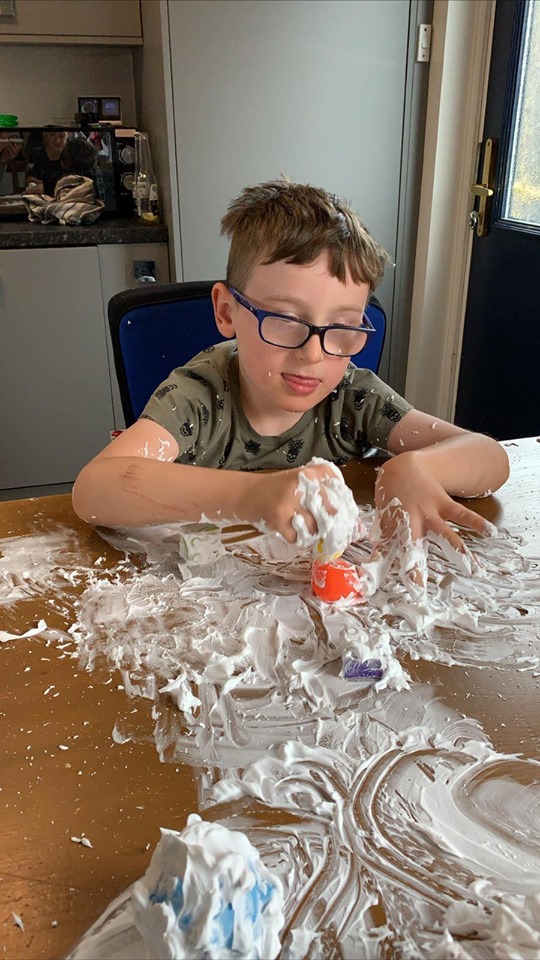
Feeling different textures is good for stimulating brain development as well as helping our child get used to different sensations. The part of the brain which feels what is happening in the fingers and what happens in the mouth are close to each other in the brain, so if a child gets used to a texture with their hands it is going to make it easier to tolerate this in their mouth. Two handed play also helps brain development, as does crossing the hands to the other side of the body.
Many children with different abilities have trouble with different textures – either feeling too much (hypersensitivity which can lead to tactile defensiveness) or not feeling enough – (leading to sensory seeking behaviours). Messy play is a controlled way to encourage tactile sensitive children to get used to different sensations. This can allow them to tolerate more of their everyday textures.
There is a strong cause and effect with messy play so children so children without much independent movement can still make a big impact which is great for learning and enjoyment.
Messy play allows for hand strengthening and developing hand-eye coordination. It provides a lot of sensory input and is a fun place for learning and developing gross and fine motor skills.
Preparation is everything! Choose a place in the home or garden for messy play activities – ideally somewhere easy to clear up. You’ll need a surface to play on: tuff spot trays are brilliant for minimising mess, but you can also use trays or containers you already have in the home, or an easy to wipe playmat or table. You’ll also need water, wipes and a towel available nearby for washing hands. Decide what material you are going to play with in advance: some activities take a little while to put together, and you also might want to consider how to make them extra motivating for your child.
Choose a time to play where you are able to join in. Messy play should be an active experience that the child initiates in some way through imitation. If a child is nervous or unsure they might want to watch someone interact with the materials first, so you need to be prepared to get stuck in! Playing together with your child also means you can watch for ways to enhance or extend their play.
Before play, it’s really nice to massage, squeeze or brush your child’s fingers, hands and forearms. This alerts their system and brings awareness to the whole upper limb. A quick finger, hand or wrist stretch can also help them feel and manipulate the messy play substance more effectively, especially if they have tight hands.
The most straight forward play technique is to help your child put their hands in the substance and let them feel around.
If your child has movement limitations, it could be beneficial to use different parts of the body for messy play. Use their feet in the substance, or put them in the bath and allow them to get covered in the messy play! This extra sensory input will allow them to learn more about their bodies as well as being great fun.
If your child is able to hold objects, or with some hand over hand help, use kitchen utensils to play with the substance – using a wooden spoon to stir, a ladle or spoons to scoop or a potato masher to squish. You can use other things from around the home as tools to further develop motor skills, like paintbrushes, rolling pins, biscuit cutters, cutlery, containers, cups or sponges.
You can also put different objects into the substance for the child to play with. This is motivating and helps build fine motor and visual perception skills. Good options include cars, plastic animals or figurines. Try dropping some items inside the substance for your child to find. Start with bigger objects so they hardly have to touch the messy play mixture; as they get more confident, hide or make the items smaller so your child has to get their hands in.
US blog Lemon Lime Adventures has compiled a list of over 41 messy play ideas – from slime, to dough, to shaving foam – and activities you’ll want to keep for outside! We were so impressed with this resource that we’ve shared it for you below.
To extend the activity, try following the messy play recipes with your child as this will introduce much of its own sensory inputs and fine motor skills.
Slime Recipes
- Soapy Slime Fun
- Lego Slime
- Simple Slime Experiments
- Glitter Slime
- Pumpkin Slime
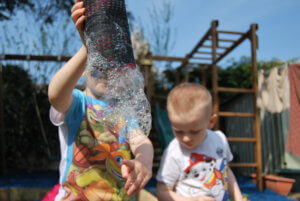
Dough Recipes - Ice Cream Playdough
- Rainbow Cloud Dough
- Fizzing PlayDough
- Electric Dough
- Fizzing Lego Bath Bombs
Oobleck Recipes - Baby Play with Goop
- Melting Goo
- Dinosaurs in Sticky Mud
- Pumpkin Spice Oobleck
- Powder Tempera Paint Recipe
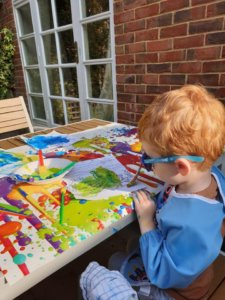
Painting Recipes for Fun - Earth Day Finger Painting
- Homemade Bath Paint
- Homemade Paint and Squeeze Bottle Painting
- Bubble Painting
- Cotton Ball Painting
- Rock Painting
- Fizzing Rubber Band Painting
- Mud Paint Recipes
Edible Recipes - Ice Cream in a Bag
- Cornflour Painting
- Ice Play
- Slime Cupcakes
- Jelly Lego Dig
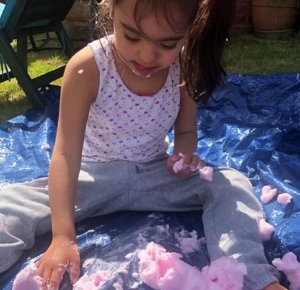
Shaving Cream Play Ideas
- Shaving Cream Ideas
- Scented Shaving Cream
- C is for Clouds
- Polka Dot Shaving Cream Paintings
- Shaving Cream Play Pool
Outdoor Messy Play Recipes - Colored Sand Recipe
- Bubble Sensory Play
- Experiment with Baking Soda
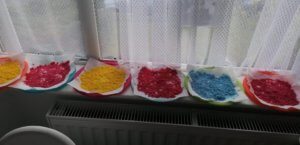
- Summer Sensory Play Recipe
- Rainbow Explosions
- Pop Rocks and Balloons Experiment
- Erupting Watermelons
- Foaming Paint






